Apple, Fennel & Rose Kouign Amann
Classic French viennoiserie with a toffee apple twist
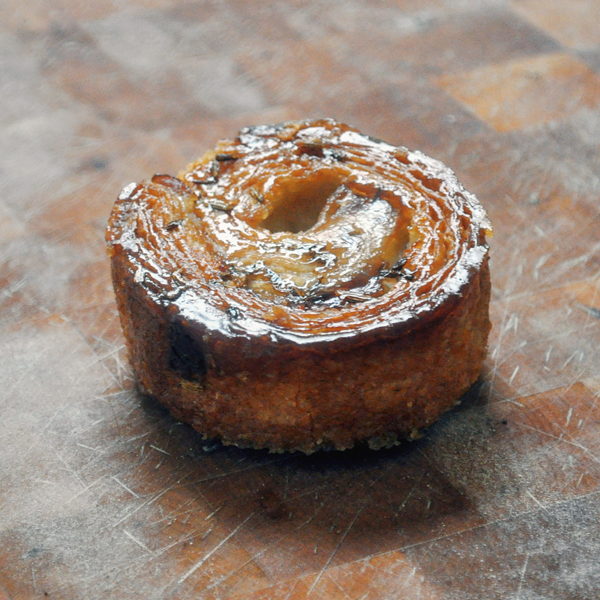
It was the hottest day of the year here in the UK yesterday - and I was out having meetings, fully suited up, sweating like a pig being eyed up by Mr. Koffman.
Strangely, we're supposed to be on our way to the Autumn equinox ... tell that to my apple trees, who's fruit should be ready for picking, but so many have spoiled in the heat.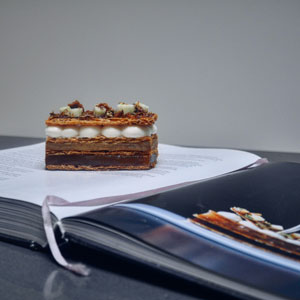
I made Heston Blumenthal's delicious "Taffety Tart" last weekend, and it gave me an idea - why not add the same apple, rose and fennel combination to something else.
Kouign Amann is a yeasted, butterry viennoiserie from Brittany made popular by GBBO a few years ago. The addition of thin apple slices and rose petals to the inside, with fennel seeds on the base gives the pastry an autumnal twist, caramelising the apples with a toffee-like flavour. I've used Bramley apples as I've got a ton of them - but also because they serve to cut through the sugar a little. I'm also resting the dough in the fridge overnight as is often the case with Croissants, which helps make them taste even better.
You're supposed to let them come to room temperature before eating - I challenge you that this is impossible after the smell fills your house.
Ingredients (makes 8 to 10 Kouign Amanns)
For the pastry
- 500g strong white flour
- 50g golden caster sugar
- 14g fast action yeast
- 200g room temperature water (~25°C)
- 50g room temperature milk (~25°C)
- 10g salt
- 100g unsalted butter - for the mix
- 250g unsalted butter - for the butter layer
For the apple puree
- 3 Bramley apples
- 50g golden caster sugar
- 100g water
For the roll in
- 100g golden caster sugar
- 3 Bramley apples
- 60g caster sugar
- 5g rose petals
For baking
- 100g golden caster sugar
- 25g unsalted butter
- 10g fennel seeds
Equipment required
- 10cm, 4cm tall tart rings
- Stand mixer
- Silicone mat
Make the dough
Mix the water, milk and sugar together then dissolve the yeast into this. Leave to stand for about 10 minutes until bubbly.Place your 500g of flour in the bowl of a stand mixer, and attach your dough hook. Pour in the yeast mix, and let it start running on a low speed until combined.
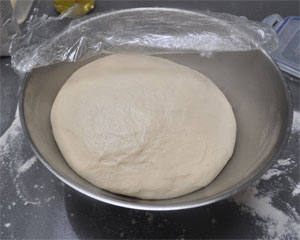 Slowly add the chopped butter, piece by piece followed by the salt. Keep it kneading for 8 minutes.
Slowly add the chopped butter, piece by piece followed by the salt. Keep it kneading for 8 minutes.
When it's ready, place into a clean, buttered bowl and cover with cling film. Let this stand until doubled in size - which will probably take 1 to 2 hours depending on your temperature or whether you put it into your proofing box.
Once it's ready, deflate the dough and flatten it into a rough rectangle. Cover it in cling film again, then place in the freezer for 30 minutes.
In the meantime, make your block of butter. Place a sheet of cling film on your work surface, then put your remaining 250g of butter (i.e. a pack!) in the middle. Cover with a second piece of cling film.
Begin to tap the butter with your rolling pin so that it softens. Eventually it will become pliable enough to roll into as perfect a square as you can. Use your hands on the upper piece of cling to straighten the edges if you need to. When you're happy with the block, place it into the freezer too.
Roll in the butter
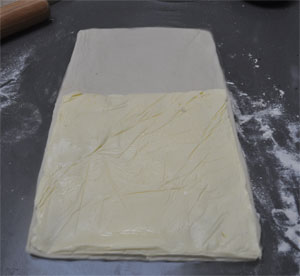 This next stage requires you to be reasonably precise with your rolling. What we're trying to do is keep the edges as straight as possible, and also to make the butter come up right to the edge - which means there won't be any part of our pastry without butter. These butterless points can create pockets which don't rise as well, so it's worth taking a time over this bit.
This next stage requires you to be reasonably precise with your rolling. What we're trying to do is keep the edges as straight as possible, and also to make the butter come up right to the edge - which means there won't be any part of our pastry without butter. These butterless points can create pockets which don't rise as well, so it's worth taking a time over this bit.
Roll out the now cold dough to as close as double the size of your butter block as you can get. If the edges aren't straight, try to re-form them with your hand or if you don't mind losing a bit of dough you can cut them off.
Remove the block of butter from the freezer, and take off the cling. Position it at the bottom half of your dough rectangle, then fold the top half over the top so that it's sandwiched in-between.
At this point, it should still be cold enough that the butter doesn't start squeezing out. Press down on the end of it do seal, then make a quarter turn with the dough (i.e. if the two ends of the pastry were facing you, turn it 90° so they move to being at a right angle to you).
Carefully roll the dough, in your body's direction, into a large rectangle about the length you made it when you were first inserting the butter block. Fold the dough, taking the furthest part away from you, and fold that 2/3 of the way back past the centre, then fold the remaining 1/3 back over the top of that (meaning you'll have 3 1/3 layers). This is turn one.
Wrap it back up in cling film, then return to the freezer for 30 minutes.
When time's up, repeat the fold process by placing the dough in front of you, with the seam you made in the last fold at a quarter turn away from you. Roll it out into a rectangle again, then perform the same 2/3 and 1/3 roll you made before. You've now made turn two.
Wrap it in cling - but this time place in the fridge and leave overnight to develop the flavours.
Make the apple puree
Peel and core the apples, then roughly chop. Place the water and sugar in a heavy based saucepan and add the apples.Let the apples simmer until they're really soft, then use a hand blender or food processor to blend them into a puree. Leave to cool then set aside.
Build the roll in
 Core and peel your remaining 3 apples. Cut in half, then Slice as thinly as you can (and I mean really thin!) - or use a mandolin if you have one.
Core and peel your remaining 3 apples. Cut in half, then Slice as thinly as you can (and I mean really thin!) - or use a mandolin if you have one.
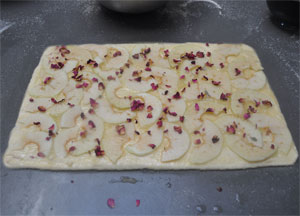 Take the dough out of the fridge and now we'll make one last turn. Repeat the fold process by placing the dough in front of you, with the seam you made in the last fold at a quarter turn away from you. Roll it out into a rectangle again, then perform the same 2/3 and 1/3 roll you made before.
Take the dough out of the fridge and now we'll make one last turn. Repeat the fold process by placing the dough in front of you, with the seam you made in the last fold at a quarter turn away from you. Roll it out into a rectangle again, then perform the same 2/3 and 1/3 roll you made before.
At this point it's worth cutting the dough in half, as it's much easier to handle two rolls of Kouign Amann pastry - it also means you can keep half the mix for another time if you want to freeze it. Wrap the half you're not using and place back in the fridge.
Take the other half and place on the work surface with the seam at 90° to you. Scatter 1/4 of the roll in sugar on top of this.
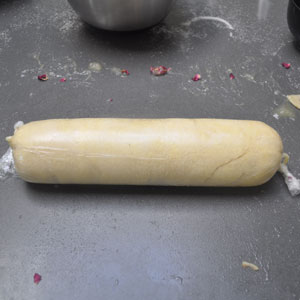 Roll the dough into a rectangle one final time, which will push the sugar into the dough.
Roll the dough into a rectangle one final time, which will push the sugar into the dough.
Place a sheet of cling on your work surface, and flip the dough onto it so that the sugar is now underneath. Brush over a thin layer of your apple puree, then scatter another 1/4 of the sugar all over this. Place slices of apple over the top, and finally scatter over the rose petals.
Now, from the longest side, start to roll the pastry, keeping it as tight as you can. When you've rolled it up entirely, bring the cling film up and over, then twist and hold the ends. Keep rolling it towards you in short strokes so that the pastry gets tighter in the middle.
Place in the freezer for 30 minutes. If you're making the other half of the dough now, repeat the process with the other half of the sugar, apples and rose petals.
Slice and proof
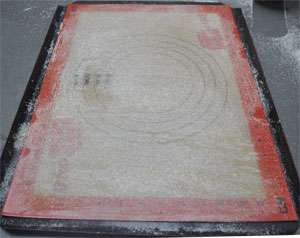 Toast your fennel seeds in a pan until they start to smoke, then remove from the heat and reserve.
Toast your fennel seeds in a pan until they start to smoke, then remove from the heat and reserve.
Heat 25g of butter, then place a silicon mat onto a heavy baking tray. Brush the butter over the entire tray, then scatter over your sugar. Shake so that it covers the entire mat. Pour any excess sugar back into a bowl.
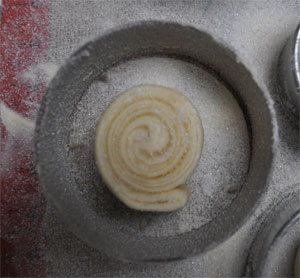 Take each pastry ring and brush it with butter too, then dip and roll each one in the bowl of sugar so that the insides are coated entirely. Place them on the mat, spread evenly, then scatter some fennel seeds inside each one and finally scatter over some more sugar (Note: Jamie Oliver would not approve).
Take each pastry ring and brush it with butter too, then dip and roll each one in the bowl of sugar so that the insides are coated entirely. Place them on the mat, spread evenly, then scatter some fennel seeds inside each one and finally scatter over some more sugar (Note: Jamie Oliver would not approve).
Remove a roll of pastry from the freezer and cut off the end. Now make slices around 2 1/2 to 3cm tall, trying to keep them as round as possible. Place each slice into one of the pastry rings.
Now leave to proof - it will take about 2 hours. Some time before they're done, pre-heat your oven to 180°C.
Bake
This is the fun bit that will have people running for your kitchen.When the pastries wobble a bit if you shake the try, they're ready. Place into your pre-heated oven and bake for 35 minutes.
After time's up, let them cool a little so that the caramelised sugar hardens.
Carefully pull each one up, breaking them out of the sugar. Trim the sides with a knife then gently push them down from the top so they fall out of the rings.
Leave to cool to room temp so they go really crispy. If you can stand to.
Salt/Sweet Popcorn Custard Tart
Popcorn flavoured custard in a popcorn pastry shell

One of my closest friends, his fiancée and their kid(s) are moving to Singapore next month, so I created this recipe - inspired by their love of American flavours - to bake them something for their going away present.
I wanted to get as much popcorn flavour in as possible, so there's toasted & ground popcorn in the pastry, the custard is infused with popcorn, and the topping ... well that's actually popcorn.
Makes 1 tart
Ingredients
For the fresh popcorn
- 110g popcorn kernels
- 3tbsp rape seed oil
For the pastry
- 10g popped corn from the above
- 215g type 55 flour or equivalent
- 3g fine sea salt
- 75g caster sugar
- 150g unsalted butter, cold from the fridge, chopped into cubes
- 1 whole large egg
- 1 large egg yolk
- Icing sugar for dusting the work surface
For the custard
- Approximately 1/2 the popped popcorn from the above
- 600g whipping cream (we only need 500g, but this includes some extra in case of popcorn absorption)
- 8 large egg yolks
- 75g caster sugar
For the topping
- All remaining popcorn
- 40g sugar
- 3g fine sea salt
- 15g unsalted butter
Equipment
- 7 inch tart case
- Baking beans
Pre-heat your oven to 220 degrees C.
Make the popcorn
The most fun part, and you'll see everyone in the house suddenly appear at the cooker. Heat 3 tablespoons of rape seed oil in a reasonably large lidded pan. When it's hot, throw in the popcorn kernels and immediately put the lid on. Shake every 20 seconds or so to make sure they don't stick. The popcorn will do its thing - as soon as the popping stops, tip into a bowl and set aside.
Make the pastry

Take 20g of the fresh popcorn and spread evenly on a baking tray. Place in your pre-heated oven and toast for around 5 minutes. It should have a slightly brown colour, but nothing more than that - so keep an eye on it.
When it's done, tip into the bowl of your food processor and blitz until it's a fine powder. You'll probably get some random un-popped kernels in there, so try to get those out before adding to the pastry.
Weigh out 10g of the ground popcorn into a bowl, then add the flour, salt and sugar. Stir it around with your hands to ensure it's all uniformly mixed. Add in the cold cubes of butter, then rub everything together by hand until you get the texture of breadcrumbs.

Next, briefly whisk the egg and egg yolk to combine, then pour this into the flour mixture and start to bring it all together by hand. Tip it out onto your work surface then, trying not to overwork it, gently push together until you get a smooth ball of pastry. Press down into a dish shape then wrap in cling film and refrigerate for an hour.
When the pastry has rested, prepare your tart tin by rubbing it lightly with butter (if you have Bake Easy spray that would also do the trick). Unwrap and dust your work surface with icing sugar, then carefully roll out the pastry until it's about 4mm thick. Fold this over your tart case and press into the corners as carefully as you can. Roll any excess over the top but don't cut it off.
This pastry is a kind of Pâte brisée, and can be quite hard to work with because of its high butter content and the fact that your corn won't absorb as much of the egg's moisture as the flour. Try not to create cracks - but if you do, just use some of the extra pastry to fill them in.
Place your tart case on a tray in the freezer for an hour, and turn the oven down to 170 degrees C.
Make the custard
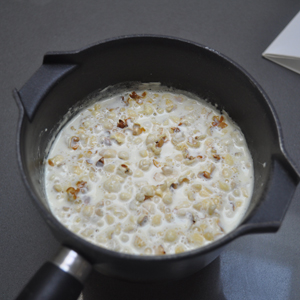
While the pastry is freezing, you can now infuse the cream with the popcorn. Pour 500ml of whipping cream into a heavy bottomed pan and heat until it just comes to the boil. Remove from the heat, then transfer to a mixing bowl. Add approximately 1/2 of the popcorn from the first stage, then use a spoon to mix it with the hot cream. Place cling film over the top and leave to steep for about 45 minutes.
When the time is up, strain the popcorn from the cream using a fine sieve, and push down with a spoon to extract as much liquid from the popcorn as you can. Weigh the cream again, top it back up to 500ml, then pour back into the heavy saucepan.
Place the egg yolks in another bowl with the sugar and move back to the pastry case.
Blind bake the case
After the case has chilled, take some silver foil and tightly cover the inside of the case, pushing it into the corners, up the sides, over the top and around the outside edges (matte side down). Fill the case with baking beans, then place in the oven for 20 minutes.
At this point the pastry, being so buttery, will have fallen off around the top of the case and you should be left with a clean edge at the top. Very carefully remove the beans & foil, then return the case to the oven for a further 10 minutes.
Remove the case from the oven, then turn it down to 130 degrees C for the final stage.
Baking the custard
Whisk the egg yolks and sugar until pale yellow, then heat the infused cream to the boil again. Pour a small amount onto the egg yolks while whisking in order to temper the eggs, then slowly add the rest of the cream.
Pour the mix through another sieve into a pouring jug, then place the pastry case back into the oven shelf. Next, pour the infused custard into the case and bake for 35 minutes until just set.
Make the topping
With the tart baked, remove from the oven and allow to cool to room temperature. Remove the tart case.
In a heavy pot, heat the 40g of caster sugar until it starts to become a caramel colour (just before the smoke point). Carefully add the salt, then the butter, and whisk until it stops bubbling. Pour this over the remaining popcorn and use a spoon to quickly mix before the caramel sets.
Place the now slightly hot popcorn onto the top of the cooled tart - the heat will allow it to sink in slightly and keep its place. As you pull the popcorn from the bowl, you'll also get some pulled sugar - so just randomly throw that over the top too.
Devour at room temperature. You'll need a really sharp knife to crack through the caramel!









